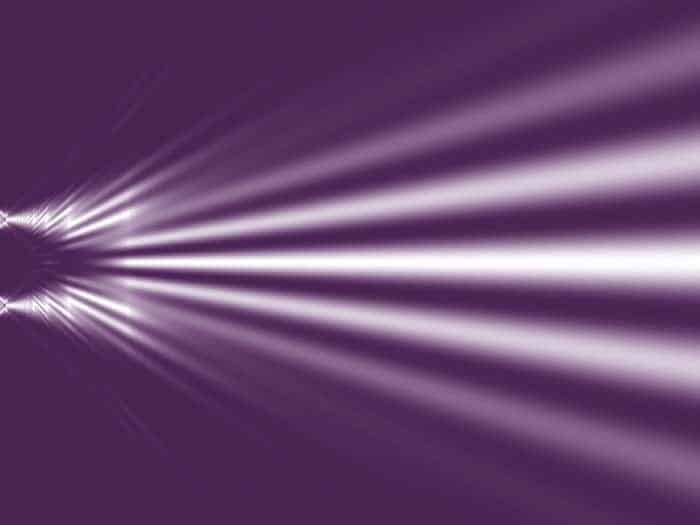
The orbital angular momentum states of light have been used to relate quantum uncertainty to wave–particle duality. The experiment was done by physicists in Europe and confirms a 2014 theoretical prediction that a minimum level of uncertainty must always result when a measurement is made on a quantum object – regardless of whether the object is observed as a wave, as a particle, or anywhere in between.
In the famous double-slit thought experiment, quantum particles such as electrons are fired one-by-one at two adjacent slits in a barrier. As time progresses, an interference pattern will build up on a detector behind the barrier. This is an example of wave–particle duality in quantum mechanics, whereby each particle travels through both slits as a wave that interferes with itself. However, if the trajectories of the particles are observed such that it is known which slit each particle travelled through, no interference pattern is seen. Since the 1970s, several different versions of the experiment have been done in the laboratory – confirming the quantum nature of reality.
Richard Feynman once described this as “a phenomenon which is impossible, absolutely impossible, to explain in any classical way, and which has in it the heart of quantum mechanics. In reality, it contains the only mystery [of quantum mechanics].” This phenomenon is known as measurement uncertainty.
Partial particles
In 1979, William Wootters and his colleague Wojciech Zurek at the University of Texas at Austin showed that wave–particle duality is not a one-or-the-other phenomenon. Instead it is possible to observe partial particle and partial wave-like behaviour, with a trade-off between the two.
This echoes another baffling element of quantum mechanics, namely preparation uncertainty. This is typified by Werner Heisenberg’s uncertainty principle. This states that one cannot know the position and momentum of a quantum object beyond a certain degree of accuracy, and the more one knows about one, the more uncertain the other becomes.
Despite Feynman’s contention that quantum mechanics contains only one real mystery, however, there is no obvious theoretical connection between measurement uncertainty and preparation uncertainty. In 2014, however, Patrick Coles and colleagues at the National University of Singapore showed theoretically that the two were equivalent. This has never been experimentally demonstrated, however.
Conjugate variables
In the new work, Guilherme Xavier at colleagues at Linköping University in Sweden set out to test the relationship between the visibility and the distinguishability of opposite states – which according to Coles’ predictions should be conjugate variables analogous to position and momentum. They sent highly attenuated, mostly single-photon laser pulses in two possible orthogonal orbital angular momentum states down an optical fibre to an input beamsplitter. Photons with opposite angular momenta emerged through different output fibres.
The researchers then used a phase modulator to add a variable phase delay to photons travelling down one of the paths. They then directed the paths to meet again at a second, tunable beamsplitter.
By placing a second modulator before the tunable beamsplitter and thereby adjusting the phase with which the two paths met, it was possible to tune the extent to which the paths recombined. This allowed them to control the extent to which the second beamsplitter actually behaved as a beamsplitter.
“When the beamsplitter is fully inserted you get interference back – this corresponds to a value in the modulator of π/2,” explains Xavier, “When you have zero in the modulator the upper path will always go to one detector and the lower path will always go to the other.”
Fixed lower bound
This latter case corresponds to a particle picture, but it provides no information about which path a particular particle has taken through the detector. The only way one can obtain that information is to prevent one of the polarizations of light from entering the second beamsplitter completely – the equivalent of blocking one of the slits in the double slit experiment. However, in this case, half of the photons are never detected at all. There is thus an unbeatable trade-off between distinguishability and visibility. They found that, no matter what they chose as the phase, there was a fixed lower bound on the measurement uncertainty that was consistent with the theory presented in 2014 by Coles and colleagues.

Do atoms going through a double slit ‘know’ if they are being observed?
The Linköping team plans to develop practical applications of its technology. “We can change the settings quite fast,” says Xavier, “so our goal is to look at the implementation of some actual quantum communication protocols using these kinds of measurements – we are looking at some delayed choice experiments based on this setup.”
Theoretical physicist Jonas Maziero of the Federal University of Santa Maria in Brazil is impressed by the work. “The experiment is innovative, it’s precise, it agrees very well with theory and it confirms an important result that’s been in the literature for more than ten years now,” he says.
He cautions, however, that the work does not fully confirm Coles’ predictions. “The result reported [by Xavier and colleagues] applies to distinguishability based complementarity-based relations that use which-path detectors to quantify the particle-like behaviour of the quantum system. There are others based on predictability and using entanglement that are not contained within this framework.” Extending the research to try to cover all cases would be interesting follow-up work, he says.
The research is described in Science Advances.



